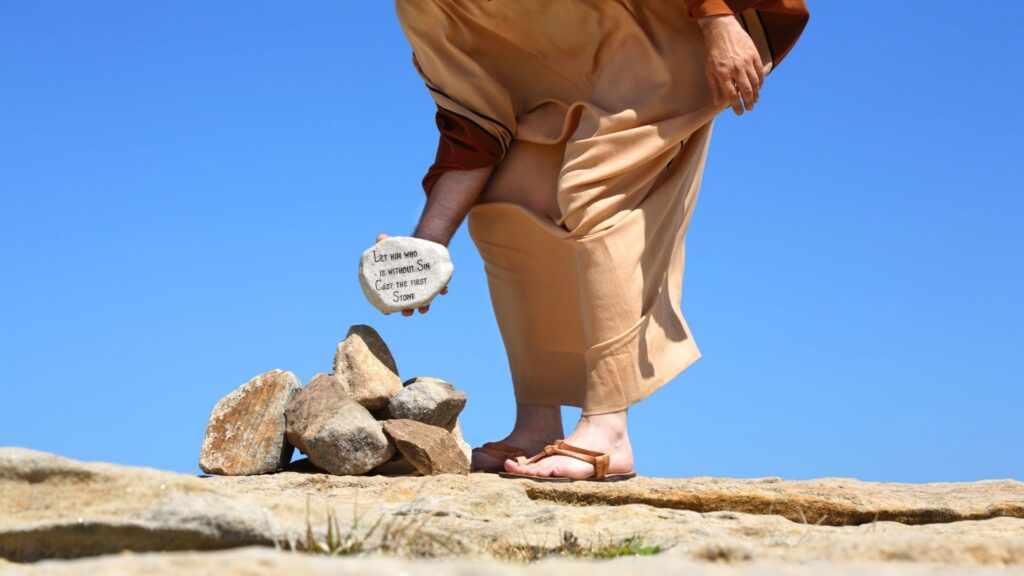Jonathan Jenkins
“Let him who is without sin among you be the first to throw a stone at her” (John 8:7).
People that have never glanced at a Bible know that phrase. In our culture, it provides cover and justification for allowing all manner of behavior to go unpunished or at least allow it to be excused. After all, no one is perfect. None of us is without sin. How could we ever be right in “casting a stone” at someone else?
The problem is our interpretation of the verse – “Don’t ever cast a stone at another” – is not what the verse says to do. Jesus is commanding that the law of God which covers the accusation made against the woman in question be carried out. His only caveat is that the law be executed in a proper manner by people with a right to do so. Jesus is commanding that the woman be stoned, if it is right for her to be stoned.
Let us set the stage here. Critics and opponents of Jesus bring to him a woman they claim was taken committing the act of adultery. This accusation is not in any way challenged by Jesus or by the woman.
The scribes and the Pharisees brought a woman who had been caught in adultery, and placing her in the midst they said to him, “Teacher, this woman has been caught in the act of adultery (John 8:3-4).
In fact, based on Jesus’ statement to her at the end of the dialogue it seems clear that the accusation about her was true. If she had committed no sin, why would she be commanded to “sin no more?”
She said, “No one, Lord.” And Jesus said, “Neither do I condemn you; go, and from now on sin no more” (John 8:11).
The challenge of Jesus’ opponents was over a proper execution of the Law of Moses. As was the case many times in the ministry of Jesus, his critics were seeking to find inconsistency in his interpretation of their law,
Now in the Law Moses commanded us to stone such women. So what do you say?” (John 8:5)
Their interpretation of the law, that an adulteress taken in the act was to be stoned is a correct one. Deuteronomy 22:22 says so very clearly,
If a man is found lying with the wife of another man, both of them shall die, the man who lay with the woman, and the woman. So you shall purge the evil from Israel.
The punishment for a capital offense under the law of Moses was stoning,
If there is found among you, within any of your towns that the LORD your God is giving you, a man or woman who does what is evil in the sight of the LORD your God, in transgressing his covenant . . . then you shall bring out to your gates that man or woman who has done this evil thing, and you shall stone that man or woman to death with stones (Deut. 17:2-5).
So, both the desire of the scribes and the Pharisees and the command of Jesus that stones should be thrown at this woman are, in fact, in perfect agreement with the law of Moses. But that is not the end of the story, and it is the rest that prevents this woman from being killed by her accusers.
There are two more principles at work that explain both Jesus’ statement and the response to it by the woman’s accusers.
First, Jesus referred to the casting of the “first stone.” That was not a remark chosen lightly. Nor was it one made to cause her accusers to reflect on their own sinfulness before executing this poor woman. It was a legal requirement. The “first stone” was to be thrown by the individuals who had brought the accusation of wrongdoing against a person. Pick up reading again in Deuteronomy 17,
. . . then you shall bring out to your gates that man or woman who has done this evil thing, and you shall stone that man or woman to death with stones. On the evidence of two witnesses or of three witnesses the one who is to die shall be put to death; a person shall not be put to death on the evidence of one witness. The hand of the witnesses shall be first against him to put him to death, and afterward the hand of all the people. So you shall purge the evil from your midst (Deut. 17:5-7).
The hand of the witnesses was be the first to move against the accused. In the instance of John 8, that means those who had witnessed her taken in the act of adultery. She was taken or caught in “the very act” (KJV) of adultery. There must have been at least two or three witness to that lewd behavior or the accusation could not have been made against her.
The second passage of the old law that is relevant is where John 8 becomes most interesting. Deuteronomy 19:15-21 sets the requirements of what is to do be done in the case of a false witness against another,
A single witness shall not suffice against a person for any crime or for any wrong in connection with any offense that he has committed. Only on the evidence of two witnesses or of three witnesses shall a charge be established. If a malicious witness arises to accuse a person of wrongdoing, then both parties to the dispute shall appear before the LORD, before the priests and the judges who are in office in those days. The judges shall inquire diligently, and if the witness is a false witness and has accused his brother falsely, then you shall do to him as he had meant to do to his brother. So you shall purge the evil from your midst. And the rest shall hear and fear, and shall never again commit any such evil among you. Your eye shall not pity. It shall be life for life, eye for eye, tooth for tooth, hand for hand, foot for foot.
If one bears false witness against another, the law demanded that he would receive the punishment that he sought to inflict upon his countrymen – an eye for an eye. In the case of a matter of capital punishment, it would mean a life for a life.
How does this relate to the situation of John 8? What is important here is the nature of their accusation. They state clearly that the woman was caught in the act of committing adultery. I know times have changed, but not that much. Then, just as now, it takes two people to commit adultery. By definition, if they caught the woman in the act of adultery, they also caught the man. Read again the provision in the Old Testament for dealing with adulterers caught in the act,
If a man is found lying with the wife of another man, both of them shall die, the man who lay with the woman, and the woman. So you shall purge the evil from Israel (Deut. 22:22)
“Both of them shall die.” That was the law. The law made no provision for the stoning of just one party. The attempt of the scribes and Pharisees to execute the woman without also executing the man is sinful. By a false and arbitrary application of the law, they were seeking death for the woman.
The question must be asked, “Where is the man?” Perhaps he is being held back to see if Jesus excuses the woman. In which case, he would then be produced to show that Jesus was advocating the breaking of Moses’ law. Perhaps he is complicit with the scheme and is wanting to see if Jesus will go beyond the law and authorize a woman’s death without sufficient evidence. In either case, the accusation against the woman is made by men who are not innocent.
Jesus’ statement now makes perfect sense and agrees with what God said should happen in Israel.
- “Let him who is without sin among you…” – If you are bearing a true witness. If your witness is false, proceed at risk of your own judgment.
- “Be the first…” – Anyone who can make a true witness was obligated by the law to act first.
- “To throw a stone at her…” – It was the demand of the law.
The witness against her was false. None could carry through with the act because to do so have placed their own lives in risk of condemnation under the law. And so, they were left with dropping the accusation or revealing their scheme. One by one, they chose the former (John 8:9).
Jesus, not being a witness to the adultery, had no legal right to press for punishment upon the woman. And so, without a proper witness against her, he relieves the woman from any danger under the law – “Neither do I commend you.” Yet, she had still committed a sin. Jesus could not allow that to go without rebuke – “. . . from now on sin no more.”
Contrary then to the popular use of this passage, Jesus is not forbidding the use of judgment. In fact, he is upholding the place of God’s law. But in so doing he also calling for the fair and righteous use of it. As the passages above reference, when God’s law is used as he intends, “evil is put away,” from among us. However, if we ever try to use it for our own ends and benefit, we fall into the danger of its judgment ourselves.

Are We Speaking Where the Bible Speaks? Part 1
There is an important question that needs to be addressed, and that question is “Are we speaking where the Bible speaks?”

Who should we blame?
We are to blame for our own sins. It is not alway easy to choose the righteous path, but we should seek to pick the righteous paths rather than the sinful, the self-serving.

Speak where the bible speaks part 2
Are we speaking where the Bible speaks? We answer this question by looking at additional illustrations of not speaking where the Bible speaks, and we acknowledge the intention of speaking where the Bible speaks.

